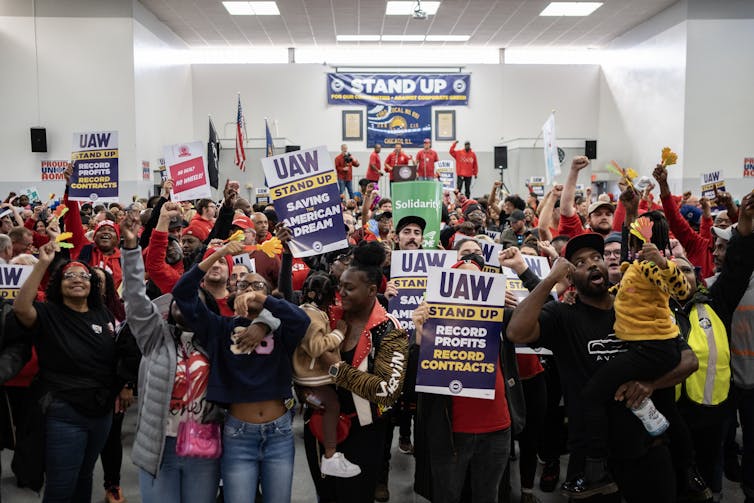The United Auto Workers union agreed on a tentative new contract with General Motors on Oct. 30, 2023, days after landing similar deals with Ford Motor Co. on Oct. 25 and Stellantis, the global automaker that makes Chrysler, Dodge and Ram vehicles in North America, on Oct. 28. The pending agreements have halted the industry’s longest strike in 25 years. It began on Sept. 15, when the UAW’s prior contracts with all three automakers expired, and lasted more than six weeks. After gradually ramping up, the strike eventually included about 46,000 workers – roughly one-third of the union’s 146,000 members at the three companies.
Ford released a statement in which it said it was “pleased” to have reached a deal and “focused on restarting Kentucky Truck Plant, Michigan Assembly Plant and Chicago Assembly Plant.” Stellantis, likewise, looks forward to “resuming operations,” as one of its executives said in a statement. General Motors initially made no public statements.
The Conversation asked Marick Masters, a Wayne State University scholar of labor and business issues, to explain what’s in these contracts and their significance.
What are the terms of the contract?
According to several media reports and the union’s own announcements, Ford’s tentative labor agreement includes a 25% wage increase over the next 4½ years, as well as the restoration of a cost-of-living allowance the UAW lost in 2009.
In addition, the tentative agreements also will convert many temporary workers to full-time status, higher pay for temps, the right to go on strike over plant closures and significant increases in contributions to retirement plans.
By the end of the period covered by the Ford, GM and Stellantis contracts, the top worker wage at assembly plants will be more than US$40 an hour. All three contracts will expire on April 30, 2028.
The Stellantis deal, according to UAW officials, is similar to the one reached with Ford in other ways – as, reportedly, is the one that the UAW agreed upon with GM.
The Stellantis agreement also has provisions regarding specific North American plants, including the plant Stellantis had idled earlier in 2023 in Belvidere, Illinois, the UAW said. Stellantis has promised to add 5,000 new jobs at Belvidere and other factories over the next four years, in stark contrast to its previous intention to cut that many jobs during the same period, UAW President Shawn Fain said on Oct. 28.
The Ford contract, likewise, calls for more than $8 billion in investments in factories and other facilities, according to the UAW.

Why did workers feel the strike was necessary, and did they achieve their aims?
The workers knew that the companies had enjoyed big profits over the past several years. GM, for example, earned $10 billion in profits in 2021 and $14.5 billion in 2022.
After having made major economic concessions to help the companies survive the Great Recession, stiff international competition and the 2009 bankruptcies of GM and Chrysler – before the latter became a division of Stellantis – UAW members believed they deserved what they’re calling a “record contract” for having contributed to “record profits.”
“The days of low-wage, unstable jobs at the Big Three are coming to an end,” Fain said on Oct. 28. “The days of the Big Three walking away from the American working class, destroying our communities, are coming to an end.”
To forge its militant strategy, the union tore a page from the playbook of labor leader Walter Reuther, who led the UAW from 1946 until his death in 1970. Reuther believed that workers deserved a fair share of corporate abundance – just like shareholders and customers.
What happens next?
The UAW released the full details of the Ford contract to all of its members who are Ford workers on Oct. 29, after its leaders had signed off on it. Rank-and-file members now have to ratify the deal for it to go into effect.
The same process will happen with Stellantis on Nov. 2. The separate deal the UAW negotiated with GM will also require ratification.
In the meantime, the autoworkers who went on strike will be returning to their jobs.
How will this affect the automakers’ bottom line?
Some analysts have estimated that Ford’s contract, if ratified, would add $1.5 billion to the company’s annual labor costs. Ford itself estimated that this could add up to $900 in labor costs to each vehicle rolling off its assembly lines. Ford has also estimated that the strike cost it about $1.3 billion in pretax profits.
To put these numbers into perspective, Ford generated slightly more than $130 billion in revenue in the first three quarters of 2023, and almost $5 billion in profits.
Stellantis has not yet made public what it believes the strike has cost the company.
General Motors has said that the strike is costing the company more than $800 million.
This article was updated on Oct. 30, after GM and the UAW reached a tentative agreement on a new labor contract.

